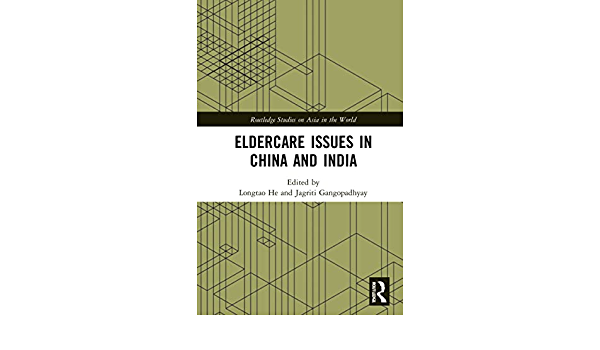
The book titled ‘Elder Care Issues in China and India’ is an edited volume with 235 pages, published by Routledge in the year 2022. This book presents the case studies of elder care in China and India and draws a comparison between the two. The rise in ageing populations worldwide and caring for the elderly has emerged as a significant challenge for the rapidly developing economies, This book highlights this key issue in the two largest Asian countries are facing.
The editors of this book, Longtao He and Jagriti Gangopadhyay, have done an excellent job by organizing the chapters on five central themes: Eldercare and filial piety, Family Care, Institutionalized and formal care, Care for the marginalized elderly, and Eldercare research. Each section contains two chapters, representing the scenario in China and India on the theme. Foregrounding the experiences of care for the elderly in China and India, the book presents the intersection of Indian and Chinese cultures of eldercare rather than directly addressing the cultural differentiation between the two. The authors used a cultural lens to explore how caregiving practices get established and sustained in joint families and what are the changing patterns in the establishment of family-based elder care in China and India.
The initial chapters talk about ‘filial piety’, which forms the basis of the family being the prime source of care for elderly people. Where the caregivers in China have been determined as more focused on the philosophical precept ‘Xiao’; the resource for filial piety in India has religious underpinning. Other chapters try to analyze community-based care and the different institutions (state and market) playing a role in eldercare in both countries. The editors have maintained the element of continuity and change while arranging the chapters; for instance, the book talks about different factors (including the very recent COVID-19) which tend to run counter to long-established cultural norms of family-based caring and filial piety. The first three sections of the book predominantly use the cultural backdrop to inquire about caregiving experiences within families, while the fourth section talks about the changing patterns in the experiences of ageing and the emergence of market mechanisms facilitating care alternatives in the neoliberal context. It discusses the reasons behind ‘family care’ getting more and more ‘less sustainable’, which leads to the rising need for institutional care in both countries. The book also acknowledges the difference between ‘eldercare within families’ and ‘eldercare at care homes’ in terms of their impact on quality of life and experiences of caregiving and receiving.
This book tries to capture the current scenario of eldercare in both countries by taking both positive and negative aspects into account. For example, it highlights the negative societal perception of older people, especially in China, despite it being known for glorifying virtues of filial piety. The book also emphasises that the elderly population is not a homogeneous category. For the experiences of marginalized elderly (single elderly in India and the elderly in China who have lost their only child) may not be the experiences of all elderly.
There are a few aspects that the book could have explored further. For instance, it fails to capture the possibility of the elderly being at the other end of the care process (willingly becoming the care provider to their children and grandchildren). It shows the elderly being just the subservient, passive receiver of care in the family or having no choice but to adopt the role of caregiver only in specific circumstances such as the death of the only child. Where the idea of filial piety has been discussed in the book in total length, the engagement with the term ‘Seva’ in the Indian context could have been better. ‘Seva’ has been discussed (at just one place in chapter 4) as a pan-Indian concept rather than a Hindu religious concept which is a matter of inquiry per se. Further, experiences of overseas communities regarding eldercare could have been captured more carefully rather than simplified to be the same as experiences within the countries. Similarly, the discussion on gendered experiences of eldercare could have been more engaging as differences in experiences of different genders while caring should have been accounted for in more length.
With these ‘few shortcomings’ and ‘many informing outcomes’, the work emerges as an essential contribution to the field of eldercare research. In the last section, the book offers crucial insight into the data available for more research of this kind. The tables attached to the tenth chapter are helpful for researchers in this field. The work acknowledges several possibilities for advancement in such research and provides a list of themes left undiscussed in the book. The last chapter is a treasure for researchers in the field because it provides a list of opportunities for future research. Overall, it is a good read, written and organized in a simplistic yet enriching manner. It can lead the reader towards a better understanding of the eldercare discourse in China and India and open the doors for newer researchers.
***
Shivangi Patel is a PhD candidate in the department of Social Sciences and Humanities at Indraprastha Institute of Information Technology (IIIT), Delhi.